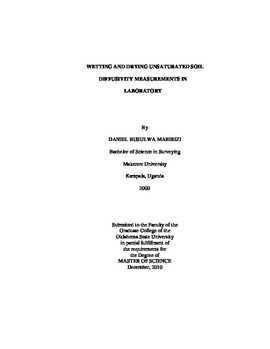| dc.contributor.advisor | Bulut, Rifat | |
| dc.contributor.author | Mabirizi, Daniel Busulwa | |
| dc.date.accessioned | 2014-04-17T19:56:14Z | |
| dc.date.available | 2014-04-17T19:56:14Z | |
| dc.date.issued | 2010-12-01 | |
| dc.identifier.uri | https://hdl.handle.net/11244/10144 | |
| dc.description.abstract | The purpose of this research study was to develop an improved and unified testing protocol for measuring both the drying (evaporation) and wetting (soaking) diffusion coefficients on the same soil specimen in the laboratory. The drying testing equipment and method are modified to accommodate the wetting test. The new testing equipment, built at Oklahoma State University, enabled drying and wetting tests to be performed in cycles on the same soil specimens. One drying-wetting or wetting-drying cycle was adopted in this study. This approach permitted the hysteresis effect on the evaporation and soaking parameters that are associated with seasonal moisture variations to be reliably evaluated. Undisturbed Shelby tube soil specimens from six different sites across Oklahoma were employed in this research study. Generally, the wetting diffusion coefficients were found to be higher than the drying diffusion coefficients by a factor of about one to two. The hysteresis between the diffusivity parameters was attributed to cracks formed in the soil during drying process and root-holes in the soil. Soils obtained from deeper depths from the ground surface tend to have smaller difference between the parameters than those obtained from shallower depths. The new testing equipment provided a strong tool for running multiple tests at the sample time under a temperature controlled environment. The determination of the diffusion coefficient by this method is simple and relatively rapid and can be carried out on a routine basis in a laboratory. The depth to which significant fluctuations in suction occur in a soil mass because of moisture fluctuations depends on the diffusion properties and amplitude of moisture fluctuations at the surface. The distribution of suction with depth within an unsaturated soil surface is greater for wetting diffusion coefficients than for drying diffusion coefficients. | |
| dc.format | application/pdf | |
| dc.language | en_US | |
| dc.publisher | Oklahoma State University | |
| dc.rights | Copyright is held by the author who has granted the Oklahoma State University Library the non-exclusive right to share this material in its institutional repository. Contact Digital Library Services at lib-dls@okstate.edu or 405-744-9161 for the permission policy on the use, reproduction or distribution of this material. | |
| dc.title | Wetting and Drying Unsaturated Soil Diffusivity Measurements in Laboratory | |
| dc.type | text | |
| dc.contributor.committeeMember | Cross, Stephen A. | |
| dc.contributor.committeeMember | Wilber, Gregory G. | |
| osu.filename | Mabirizi_okstate_0664M_11147.pdf | |
| osu.college | Engineering, Architecture, and Technology | |
| osu.accesstype | Open Access | |
| dc.description.department | School of Civil & Environmental Engineering | |
| dc.type.genre | Thesis | |
| dc.subject.keywords | diffusion coefficients | |
| dc.subject.keywords | drying | |
| dc.subject.keywords | mitchell | |
| dc.subject.keywords | moisture | |
| dc.subject.keywords | unsaturated soil | |
| dc.subject.keywords | wetting | |
